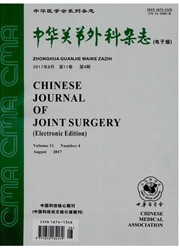

 中文摘要:
中文摘要:
目的探讨基于MRI技术的全膝关节置换(TKA)术中个体化导航模板定位截骨的准确性与可行性。方法选取保存完好的成年尸体下肢标本16具,将尸体标本随机分为导航模板组(模板组)和传统手术组(传统组),每组8具16个膝关节。模板组术前行双下肢髋-膝-踝MRI扫描,通过三维重建软件、计算机辅助设计及逆向工程软件对数据进行处理,设计制作出与股骨远端和胫骨近端匹配的个体化截骨导航模板实物,用于TKA手术的截骨定位。传统组按常规人工TKA手术程序进行操作。术后两组均摄整个下肢全长正侧位X线片,测量比较两组假体组件的角度;两组取出膝关节假体后行全下肢CT扫描,比较冠状位下两种方法定位截骨后股骨远端截骨面与股骨机械轴线、胫骨近端截骨面与胫骨机械轴线的垂直关系及轴位下股骨后髁截骨面与外科髁上轴的平行关系。对测得参数进行比较采用两样本t检验,检验水准α值取0.05。结果本组研究共设计制作了32个个体化导航模板,辅助TKA16例。术中所有的导航模板和股骨髁与胫骨平台贴附性较好,无明显偏差。(1)术后测量假体位置:正位X线片测量:模板组FFC平均偏差角度为(1.2±0.2)°,传统组FFC平均偏差角度为(2.4±0.3)°;模板组FTC平均偏差角度为(1.4±0.3)°,传统组FTC平均偏差角度为(2.3±0.4)°。侧位X线片测量:模板组LFC平均偏差角度为(6.8±0.2)°,传统组LFC平均偏差角度为(9.2±0.4)°;模板组LTC平均偏差角度为(2.4±0.1)°,传统组LTC平均偏差角度为(4.8±0.6)°。模板组FFC、FTC、LFC、LTC平均偏差角度均小于传统组,差异均有统计学意义(P均小于0.05)。(2)术后CT测量截骨面与其机械轴线垂直关系:模板组:16例膝关节的股骨远端截骨面与股骨机械轴线成角88.9°~91.1°,平均90.1°,胫骨近端截骨面与胫骨机械轴线成角89.6°~90.7°,平
 英文摘要:
英文摘要:
Objective To investigate the accuracy and feasibility of individual navigation templates based on MRI technology for accurate osteotomy in total knee arthroplasty( TKA). Methods Sixteen well preserved adult cadaver lower limbs were selected,and were randomly divided into the navigation template group( the template group) and the traditional surgery group( the tradition group),eight specimens with16 knees in each group. The template group underwent preoperative hip-knee-ankle MRI on both sides.Using three-dimentional( 3D) reconstruction software,computer-assissted design and reverse engineering software,the individual osteotomy navigation templates matching the distal femur and proximal tibia were made based on the MRI data,and these templates were used to assist the osteotomy in TKA. The conventional group underwent conventional TKA procedure. The prosthetic components angles of the two groups were measured and compared postoperatively by the full-length anteroposterior and lateral radiographs of the bilateral lower limbs. CT scan was performed postoperatively to evaluate the perpendicular relations of the distal femur and the proximal tibia to its mechanical axis in the coronal plane,as well as the parallel relation of the femoral posterior condylar surface to the surgical transepicondylar axis in the horizontal position. The t test of two independent-samples was performed,and the significant level was set as α = 0. 05. Results Thirty-two individual navigation templates were designed in this study,which were used to assist 16 cases of TKA. During the surgery,all the individual navigation templates fitted well with the femoral condyle and the tibial plateau.( 1) The prosthetic location measured postoperatively by X-ray. Anteroposterior X-ray measurement: the average deviation of FFC in the template group was( 1. 2 ± 0. 2) ° and( 2. 4 ± 0. 3) ° in the traditional group; the average deviation of FTC in the template group was( 1. 4 ± 0. 3) ° and( 2. 3 ± 0. 4) ° in the t
 同期刊论文项目
同期刊论文项目
 同项目期刊论文
同项目期刊论文
 Accuracy and efficacy of osteotomy in total knee arthroplasty with patient-specific navigational tem
Accuracy and efficacy of osteotomy in total knee arthroplasty with patient-specific navigational tem 期刊信息
期刊信息
